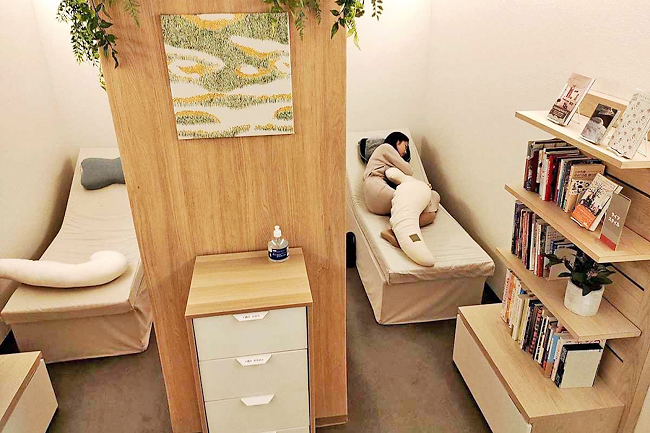ANN/THE YOMIURI SHIMBUN – With a growing emphasis on employee well-being in workplaces, the adoption of power naps as a means of revitalisation is increasingly prevalent. Companies are introducing innovative solutions such as nap pods and designated rest areas to enhance rejuvenating sleep experiences.
During lunch breaks at Koyoju Plywood Corp in Asahikawa, Hokkaido, for instance, employees enter a cylindrical pod, measuring approximately 1.2 metres in diameter and 2.5 metres in height, innovatively designed by the company itself.
This progressive approach underscores a burgeoning trend in workplace culture, underscoring the significance of revitalisation amidst the daily hustle and bustle.
The box is designed to support the napper at four points: their head, buttocks, shins and soles of the feet, so there is no stress on the body. The height of the cushions can be adjusted to suit the users’ physique. The door can be closed for privacy. The box also has wheels for easy transportation.
“I can take a quick break and feel refreshed,” said a female employee, 37, who says she often uses the box when she feels tired from processing work. But why sleep standing up? The company’s president, Hironari Yamaguchi, 56, said he came up with the concept from the sight of a giraffe sleeping standing up. “It saves space and allows people to get back to work without falling asleep too deeply,” he said. The product was completed following joint research with universities and other entities and was named “giraffenap”.


When the product went on sale in January, priced JPY3.3 million each, three companies and one local government decided to introduce it to their workplaces. Koyoju Plywood said it has received about 570 inquiries from companies, hospitals and elsewhere.
Japanese sleep an average of seven hours and 22 minutes a night, the shortest among 33 countries surveyed by the Organisation for Economic Cooperation and Development in 2021.
According to the 2019 National Health and Nutrition Survey by the Health, Labour and Welfare Ministry, 32.3 per cent of men and 36.9 per cent of women said they felt sleepy during the day at least three times a week.
Against this backdrop, companies are introducing the practice of power naps in the office.
Nishikawa Co, a bedding manufacturer headquartered in Tokyo, is pursuing the quality of napping.
It set up “quick nap rooms” in its offices in Tokyo and Osaka. The room is equipped with the company’s top-quality mattresses and body pillows, and a starry planetarium is projected across the ceiling. The light and sound are automatically controlled, allowing users to comfortably sleep for about 20 minutes and wake up naturally.
Mitsubishi Estate Co in January rolled out a shared resting room equipped with napping chairs in private compartments and massage equipment, on the first floor of an office building in Otemachi, central Tokyo, on an experimental basis.
Under the name Tomarigi (perch), the room is shared by 30 companies and organisations nearby that do not have napping spaces.
“Power naps refresh the brain and lead to recovery from fatigue and improve productivity,” said sleep specialist and director Satoru Tsubota of Amaharashi Clinic in Toyama Prefecture.
“Companies should proactively introduce them as a way of reforming how workers take breaks.”
Mitsuo Hayashi, professor of sleep science at Hiroshima University, recommends taking a nap for 15 to 20 minutes between noon and 3pm to avoid affecting nighttime sleep.
He said that beds and backrests should be inclined at around 30 to 60 degrees and recommended people to take some caffeine, such as coffee or green tea, before napping to feel refreshed upon waking up. “After understanding the actual state of sleep among workers, companies are recommended to foster a workplace culture and environment in which people can easily take power naps,” the professor said.






